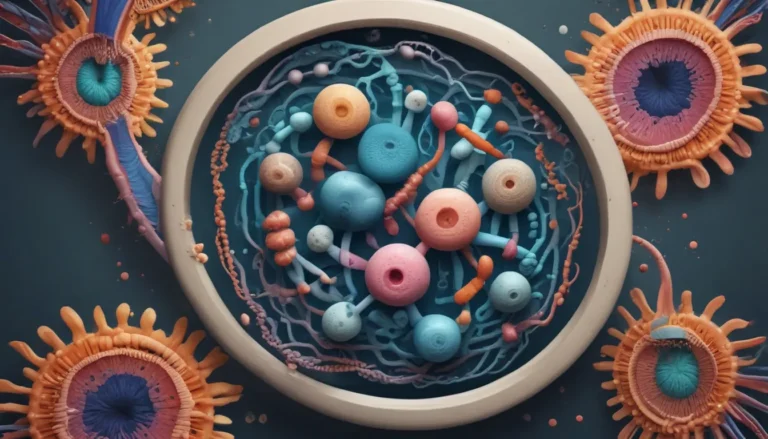A Note About Images: The images used in our articles are for illustration purposes only and may not exactly match the content. They are meant to engage readers, but the text should be relied upon for accurate information.
Welcome to the captivating world of biogeochemical cycles, where the intricate dance of essential elements shapes the fabric of life on Earth. From the carbon cycle driving climate change to the nitrogen cycle fueling plant growth, these cycles are the backbone of our planet’s ecosystems. Let’s embark on a journey to uncover 20 enigmatic facts about biogeochemical cycles, shedding light on their importance and impact on both nature and humanity.
Understanding the Essence of Biogeochemical Cycles
Biogeochemical cycles serve as nature’s recycling system, ensuring the continuous movement and transformation of crucial nutrients and elements. These cycles, including the carbon, nitrogen, and phosphorus cycles, are vital for sustaining life on Earth by regulating the flow of energy through ecosystems.
- Human actions can disrupt the balance of biogeochemical cycles, leading to environmental challenges such as climate change and nutrient pollution.
- Learning about these cycles empowers us to make informed choices that support a healthy planet and address pressing environmental issues.
Unraveling the Carbon Cycle’s Influence on Climate Change
Central to the Earth’s climate system, the carbon cycle involves the exchange of carbon between the atmosphere, land, and oceans. Carbon dioxide, a greenhouse gas, contributes to global warming by trapping heat in the atmosphere.
The Significance of the Nitrogen Cycle for Plant Growth
Essential for synthesizing proteins and other vital compounds, nitrogen is a key element in the growth of plants. The nitrogen cycle transforms nitrogen gas into usable forms that support the flourishing of plant life.
The Impact of Human Activities on Biogeochemical Cycles
Through activities like burning fossil fuels and deforestation, humans have disrupted the natural balance of biogeochemical cycles. This disruption has led to issues such as air and water pollution, biodiversity loss, and climate change.
Delving into the Phosphorus Cycle’s Role in DNA and Energy Transfer
Phosphorus, a critical component of DNA, RNA, and ATP, plays a pivotal role in cellular energy transfer. The phosphorus cycle involves the movement of this essential nutrient through rocks, soil, water, and living organisms.
Embracing the Interconnectedness of the Water Cycle
Acting as a conduit for transporting nutrients and minerals, water connects different biogeochemical cycles. From evaporation to precipitation, the water cycle ensures the continuous circulation of essential elements.
Exploring the Influence of the Sulfur Cycle on Atmospheric Chemistry
Sulfur compounds released into the atmosphere can impact air quality and climate by forming aerosols or reacting with other gases. The sulfur cycle involves the movement of sulfur through the atmosphere, soil, and living organisms.
Cultivating Ecosystem Stability Through Biogeochemical Cycles
By regulating the availability and distribution of nutrients, biogeochemical cycles promote ecosystem stability and resilience. These cycles play a vital role in maintaining species diversity and the sustainability of biological communities.
Nurturing Sustainable Practices to Support Biogeochemical Cycles
Through initiatives like recycling, sustainable agriculture, and carbon emissions reduction, individuals and communities can contribute to maintaining the balance of biogeochemical cycles. Sustainable practices are key to preserving the health of our planet.
Fostering Food Security Through Balanced Biogeochemical Cycles
Stable biogeochemical cycles are essential for ensuring the availability of essential nutrients for crop production and global food security. Practices like nutrient recycling and soil conservation play a crucial role in maintaining this balance.
Harnessing the Oxygen Cycle’s Importance for Aerobic Life Forms
Fundamental for respiration, oxygen moves between the atmosphere, oceans, and terrestrial ecosystems, supporting energy production and aerobic organisms’ survival.
Reflecting on the Interconnected Cycles of Life and Death
As organisms decompose, nutrients are released back into the environment, fueling the continuation of biogeochemical cycles. Decomposition is a vital step in recycling organic matter and sustaining ecosystem health.
Responding to Natural Disruptions in Biogeochemical Cycles
Natural events like volcanic eruptions, earthquakes, and floods can impact biogeochemical cycles by altering nutrient availability, soil composition, and water quality. Ecosystems must adapt and recover from these disturbances.
Adapting to Global Challenges Through Biogeochemical Understanding
The study of biogeochemical cycles is crucial for addressing pressing environmental issues like climate change, pollution, and ecosystem degradation. By understanding these cycles, we can develop sustainable solutions for a healthier planet.
In conclusion, the intricate web of biogeochemical cycles sustains life on Earth, highlighting the interconnectedness of all living organisms and the environment. By embracing and respecting these cycles, we can safeguard the delicate balance necessary for life to flourish. Let’s continue our exploration of the wonders of biogeochemical cycles and appreciate the beauty and complexity of nature’s ingenious systems.
FAQs:
-
What are biogeochemical cycles?
Biogeochemical cycles are natural processes involving the cycling of elements and nutrients among living organisms, the atmosphere, bodies of water, and the Earth’s crust. -
Why are biogeochemical cycles important?
Biogeochemical cycles are crucial for sustaining ecosystems and life on Earth by regulating the flow of essential elements like carbon, nitrogen, and phosphorus. -
How many types of biogeochemical cycles are there?
There are various types of biogeochemical cycles, including the water cycle, carbon cycle, nitrogen cycle, phosphorus cycle, and sulfur cycle. -
What is the significance of the water cycle?
The water cycle redistributes freshwater across the planet, ensuring its availability for all living organisms through processes like evaporation and precipitation. -
How do human activities impact biogeochemical cycles?
Human actions, such as deforestation and industrial pollution, can disrupt biogeochemical cycles, leading to imbalances that affect ecosystems and contribute to climate change. -
Can biogeochemical cycles be restored or repaired?
While some damage can be reversed through conservation efforts, preventing further harm through sustainable practices is essential in restoring the balance of biogeochemical cycles. -
How do biogeochemical cycles relate to climate change?
Biogeochemical cycles, like the carbon cycle, are closely linked to climate change. Excessive greenhouse gas emissions disrupt these cycles, contributing to global warming and climate instability.
Embrace the awe-inspiring complexity of biogeochemical cycles and their profound impact on our planet. Let’s continue our journey of discovery and preservation, ensuring a sustainable future for generations to come.






